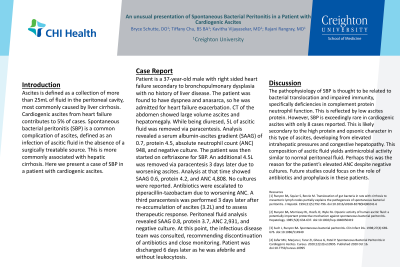Back


Poster Session B - Monday Morning
Category: Liver
B0554 - Persistent Spontaneous Bacterial Peritonitis in a Patient With Cardiogenic Ascites
Monday, October 24, 2022
10:00 AM – 12:00 PM ET
Location: Crown Ballroom

Has Audio

Kavitha Vijayasekar, MD
Icahn School of Medicine at Mount Sinai (Emlhurst) Hospital
Omaha, NE
Presenting Author(s)
Bryce Schutte, DO1, Tiffany Chu, BS, BA2, Kavitha Vijayasekar, MD3, Rajani Rangray, MBBS1
1CHI Creighton University Medical Center, Omaha, NE; 2Creighton University School of Medicine, Hayward, CA; 3Creighton University, Omaha, NE
Introduction: Ascites is defined as a collection of more than 25mL of fluid in the peritoneal cavity, most commonly caused by liver cirrhosis. Cardiogenic ascites from heart failure contributes to 5% of cases. Spontaneous bacterial peritonitis (SBP) is a common complication of ascites, defined as an infection of ascitic fluid in the absence of a surgically treatable source. This is more commonly associated with hepatic cirrhosis. Here we present a case of SBP in a patient with cardiogenic ascites.
Case Description/Methods: Patient is a 37-year-old male with right sided heart failure secondary to bronchopulmonary dysplasia with no history of liver disease. The patient was found to have dyspnea and anasarca, so he was admitted for heart failure exacerbation. CT of the abdomen showed large volume ascites and hepatomegaly. While being diuresed, 5L of ascitic fluid was removed via paracentesis. Analysis revealed a serum albumin-ascites gradient (SAAG) of 0.7, protein 4.5, absolute neutrophil count (ANC) 948, and negative culture. The patient was then started on ceftriaxone for SBP. An additional 4.5L was removed via paracentesis 3 days later due to worsening ascites. Analysis at that time showed SAAG 0.6, protein 4.2, and ANC 4,808. No cultures were reported. Antibiotics were escalated to piperacillin-tazobactam due to worsening ANC. A third paracentesis was performed 3 days later after reaccumulation of ascites (3.2L) and to assess therapeutic response. Peritoneal fluid analysis revealed SAAG 0.8, protein 3.7, ANC 2,931, and negative culture. At this point, the infectious disease team was consulted, recommending discontinuation of antibiotics and close monitoring. Patient was discharged 6 days later as he was afebrile and without leukocytosis.
Discussion: The pathophysiology of SBP is thought to be related to bacterial translocation and impaired immunity, specifically deficiencies in complement protein neutrophil function. This is reflected by low ascites protein. However, SBP is exceedingly rare in cardiogenic ascites with only 8 cases reported. This is likely secondary to the high protein and opsonic character in this type of ascites, developing from elevated intrahepatic pressures and congestive hepatopathy. This composition of ascites fluid yields antimicrobial activity similar to normal peritoneal fluid. Perhaps this was the reason for the patient’s elevated ANC despite negative cultures. Future studies could focus on the role of antibiotics and prophylaxis in these patients.
Disclosures:
Bryce Schutte, DO1, Tiffany Chu, BS, BA2, Kavitha Vijayasekar, MD3, Rajani Rangray, MBBS1. B0554 - Persistent Spontaneous Bacterial Peritonitis in a Patient With Cardiogenic Ascites, ACG 2022 Annual Scientific Meeting Abstracts. Charlotte, NC: American College of Gastroenterology.
1CHI Creighton University Medical Center, Omaha, NE; 2Creighton University School of Medicine, Hayward, CA; 3Creighton University, Omaha, NE
Introduction: Ascites is defined as a collection of more than 25mL of fluid in the peritoneal cavity, most commonly caused by liver cirrhosis. Cardiogenic ascites from heart failure contributes to 5% of cases. Spontaneous bacterial peritonitis (SBP) is a common complication of ascites, defined as an infection of ascitic fluid in the absence of a surgically treatable source. This is more commonly associated with hepatic cirrhosis. Here we present a case of SBP in a patient with cardiogenic ascites.
Case Description/Methods: Patient is a 37-year-old male with right sided heart failure secondary to bronchopulmonary dysplasia with no history of liver disease. The patient was found to have dyspnea and anasarca, so he was admitted for heart failure exacerbation. CT of the abdomen showed large volume ascites and hepatomegaly. While being diuresed, 5L of ascitic fluid was removed via paracentesis. Analysis revealed a serum albumin-ascites gradient (SAAG) of 0.7, protein 4.5, absolute neutrophil count (ANC) 948, and negative culture. The patient was then started on ceftriaxone for SBP. An additional 4.5L was removed via paracentesis 3 days later due to worsening ascites. Analysis at that time showed SAAG 0.6, protein 4.2, and ANC 4,808. No cultures were reported. Antibiotics were escalated to piperacillin-tazobactam due to worsening ANC. A third paracentesis was performed 3 days later after reaccumulation of ascites (3.2L) and to assess therapeutic response. Peritoneal fluid analysis revealed SAAG 0.8, protein 3.7, ANC 2,931, and negative culture. At this point, the infectious disease team was consulted, recommending discontinuation of antibiotics and close monitoring. Patient was discharged 6 days later as he was afebrile and without leukocytosis.
Discussion: The pathophysiology of SBP is thought to be related to bacterial translocation and impaired immunity, specifically deficiencies in complement protein neutrophil function. This is reflected by low ascites protein. However, SBP is exceedingly rare in cardiogenic ascites with only 8 cases reported. This is likely secondary to the high protein and opsonic character in this type of ascites, developing from elevated intrahepatic pressures and congestive hepatopathy. This composition of ascites fluid yields antimicrobial activity similar to normal peritoneal fluid. Perhaps this was the reason for the patient’s elevated ANC despite negative cultures. Future studies could focus on the role of antibiotics and prophylaxis in these patients.
Disclosures:
Bryce Schutte indicated no relevant financial relationships.
Tiffany Chu indicated no relevant financial relationships.
Kavitha Vijayasekar indicated no relevant financial relationships.
Rajani Rangray indicated no relevant financial relationships.
Bryce Schutte, DO1, Tiffany Chu, BS, BA2, Kavitha Vijayasekar, MD3, Rajani Rangray, MBBS1. B0554 - Persistent Spontaneous Bacterial Peritonitis in a Patient With Cardiogenic Ascites, ACG 2022 Annual Scientific Meeting Abstracts. Charlotte, NC: American College of Gastroenterology.
